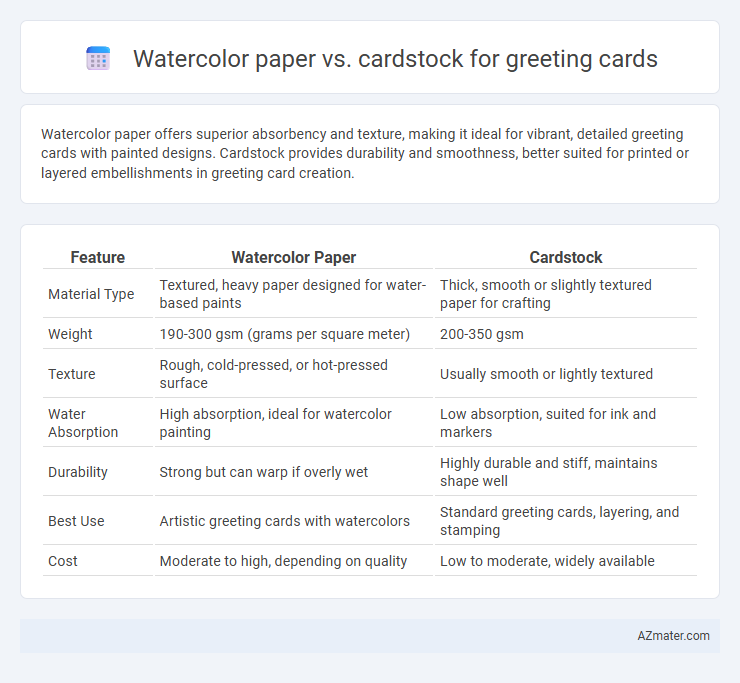Watercolor paper offers superior absorbency and texture, making it ideal for vibrant, detailed greeting cards with painted designs. Cardstock provides durability and smoothness, better suited for printed or layered embellishments in greeting card creation.
Table of Comparison
| Feature | Watercolor Paper | Cardstock |
|---|---|---|
| Material Type | Textured, heavy paper designed for water-based paints | Thick, smooth or slightly textured paper for crafting |
| Weight | 190-300 gsm (grams per square meter) | 200-350 gsm |
| Texture | Rough, cold-pressed, or hot-pressed surface | Usually smooth or lightly textured |
| Water Absorption | High absorption, ideal for watercolor painting | Low absorption, suited for ink and markers |
| Durability | Strong but can warp if overly wet | Highly durable and stiff, maintains shape well |
| Best Use | Artistic greeting cards with watercolors | Standard greeting cards, layering, and stamping |
| Cost | Moderate to high, depending on quality | Low to moderate, widely available |
Introduction to Greeting Card Paper Choices
Greeting card paper choices significantly impact the final presentation and durability, with watercolor paper and cardstock being popular options. Watercolor paper, known for its textured surface and excellent absorbency, enhances artistic designs but tends to be thicker and more expensive. Cardstock offers a smooth finish, affordability, and sturdy support ideal for printing and handwritten messages, making it a versatile choice for everyday greeting cards.
What is Watercolor Paper?
Watercolor paper is a heavy, textured paper specifically designed to absorb water and pigments, making it ideal for painting with watercolor paints. It typically ranges from 140 lb (300 gsm) to 300 lb (640 gsm), offering durability and preventing warping or buckling during wet media application. Compared to cardstock, watercolor paper provides better color retention and blending capabilities, essential for vibrant and detailed greeting card designs.
What is Cardstock?
Cardstock is a thick, durable paper commonly used for greeting cards due to its sturdy texture and ability to hold ink well without bleeding. Unlike watercolor paper, which is designed to absorb and blend water-based paints, cardstock provides a smooth surface ideal for crisp printing and detailed embellishments. Its weight typically ranges from 65 lb to 110 lb, making it a versatile choice for crafting personalized, professional-looking greeting cards.
Surface Texture: Watercolor Paper vs Cardstock
Watercolor paper features a rough, textured surface designed to absorb and hold watercolor paints, offering a rich, tactile feel that enhances artistic effects on greeting cards. Cardstock typically has a smooth, even texture that provides a clean, crisp surface ideal for printing and sharp designs but lacks the absorbency needed for watercolor mediums. Choosing watercolor paper imparts an artisanal quality and texture, while cardstock emphasizes durability and print clarity for greeting cards.
Weight and Thickness Comparison
Watercolor paper typically ranges from 140 lb (300 gsm) to 300 lb (640 gsm), offering substantial thickness and durability ideal for wet media, while cardstock usually falls between 65 lb (176 gsm) and 110 lb (300 gsm), making it lighter and less absorbent. The heavyweight and textured surface of watercolor paper prevent warping and buckling when using water-based paints, contrasting with cardstock's smoother finish designed primarily for printing or dry media. Choosing between them depends on the need for rigidity and absorbency, as watercolor paper's thickness enhances artistic effects, whereas cardstock provides easier folding and crisp creases for greeting cards.
Ink and Paint Absorption Differences
Watercolor paper features a highly absorbent texture designed to hold water-based paints without warping, allowing inks and paints to dry evenly and vibrantly on greeting cards. Cardstock, with its smoother and less porous surface, tends to repel ink and paint, often causing smudging or slower drying times when using water-based mediums. For optimal ink and paint absorption in greeting card projects, watercolor paper enhances color intensity and detail, while cardstock works better with dry or minimal moisture applications.
Durability and Longevity
Watercolor paper offers superior durability and longevity for greeting cards due to its thick fibers and high absorbency, preventing warping and color fading over time. Cardstock, while sturdier and less prone to bending, tends to be less absorbent, which can cause ink and paint to sit on the surface and potentially crack or peel. Choosing watercolor paper ensures a more enduring and resilient card, especially when using water-based media.
Printability and Compatibility
Watercolor paper offers a textured surface that enhances the visual appeal of printed designs but may cause ink to spread or bleed, affecting print clarity on greeting cards. Cardstock, being smoother and denser, provides superior printability with sharp, vibrant colors and is highly compatible with most inkjet and laser printers. Choosing between watercolor paper and cardstock depends on balancing artistic texture against the need for precise, high-quality printing in greeting card production.
Cost Considerations
Watercolor paper typically costs more than cardstock due to its higher weight and texture designed to absorb water without warping, making it ideal for artistic greeting cards but less budget-friendly. Cardstock offers a more affordable option with a smooth surface suitable for printing and mass production, providing a cost-effective choice for bulk greeting cards. Choosing between the two depends on balancing budget constraints and the desired artistic quality of the final product.
Best Uses: Choosing the Right Paper for Your Greeting Card
Watercolor paper excels for greeting cards featuring hand-painted designs or intricate water-based artwork due to its textured surface and superior absorbency, which prevents warping and color bleeding. Cardstock is ideal for cards requiring a smooth, sturdy base for printing, stamping, or die-cut embellishments, providing clean lines and durability. Selecting between watercolor paper and cardstock depends on the desired artistic effect and technique, ensuring the final greeting card matches both aesthetic and functional needs.

Infographic: Watercolor paper vs Cardstock for Greeting card
 azmater.com
azmater.com